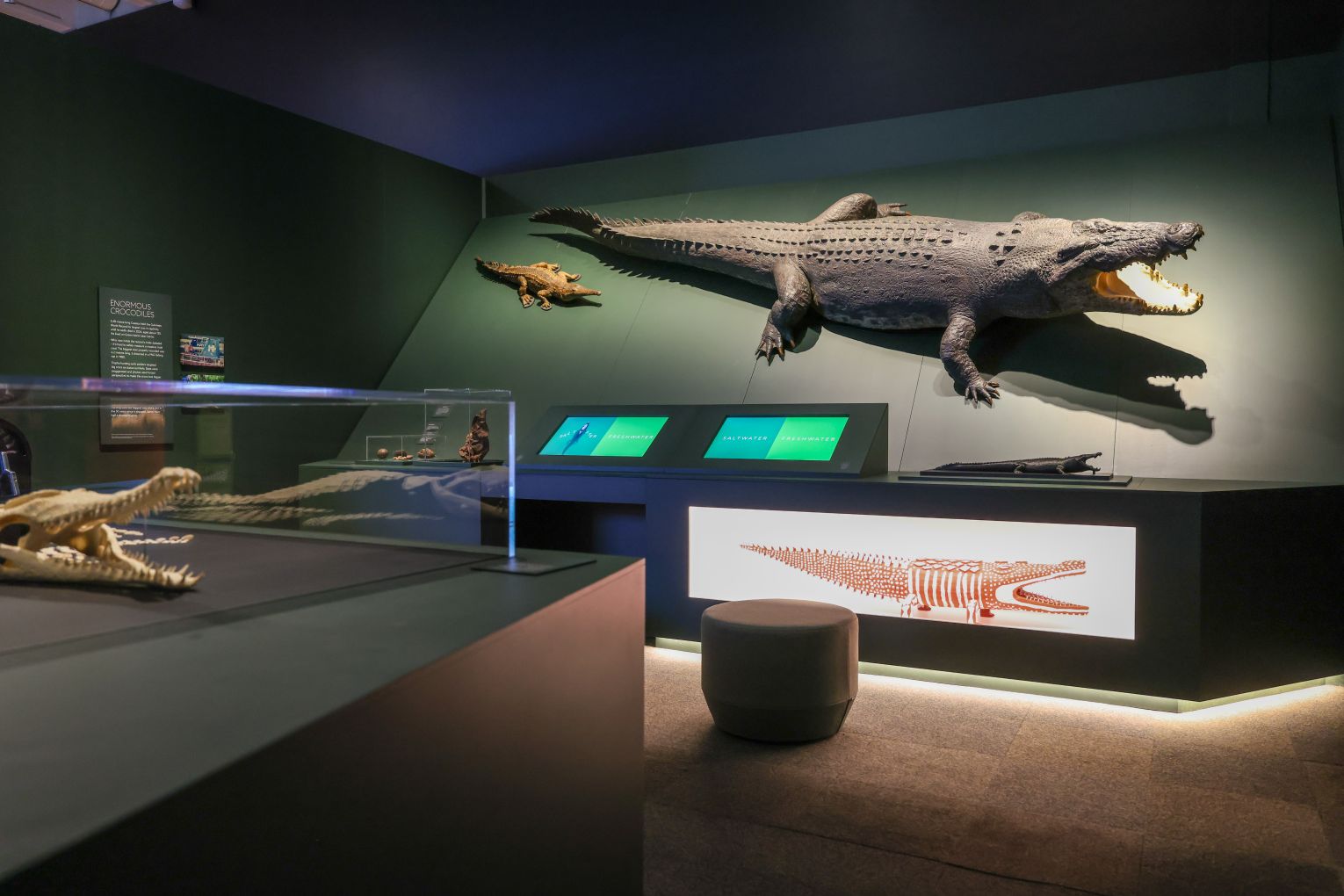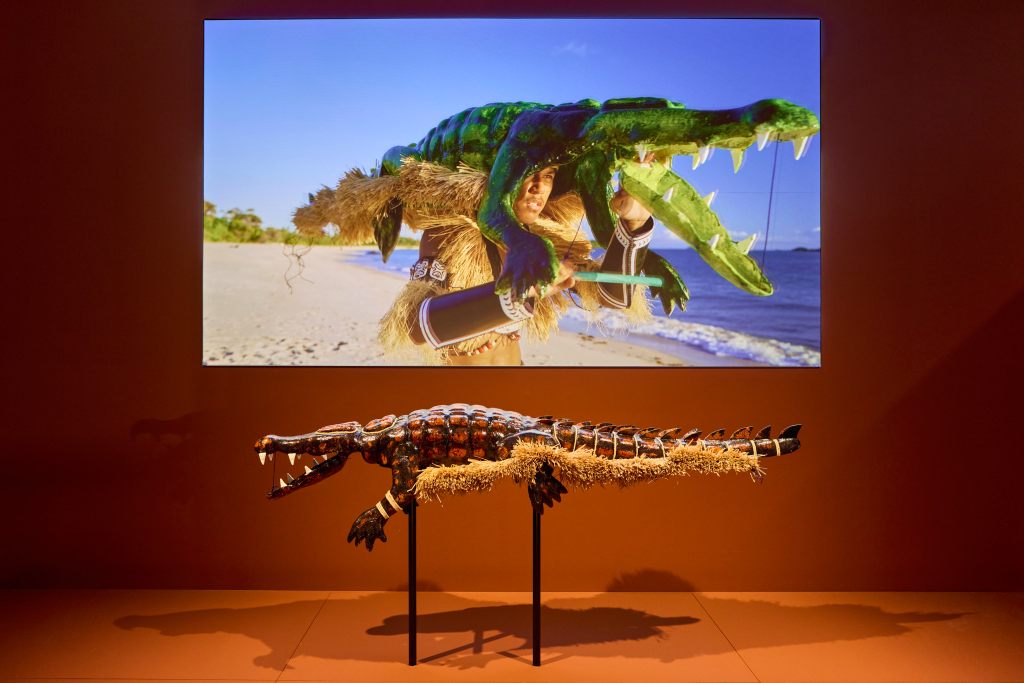What a croc! Our apex predator gets its own show
A new exhibition at Queensland Museum Kurilpa is a fascinating deep dive into the story of one of our most feared apex predators.

What does one wear to a crocodile exhibition? I asked myself this question as I browsed through the exhibits at Croc! Lost Giants to Living Legends now on at Queensland Museum Kurilpa.
It was when I got to the section dealing with popular culture that I twigged – I was dressed appropriately, wearing a Lacoste polo shirt and Lacoste socks. If I’d had my Lacoste manbag with me, I would have had the trifecta.
I hope that doesn’t sound too superficial, but there in the pop culture section was a nod to Lacoste because, of course, this leisure fashion brand’s symbol is, yes, a crocodile.
There are other pop cultural references including some stuff about the film Crocodile Dundee. Nice that the museum doesn’t take itself too seriously and is canny enough to think beyond the scientific stuff.
The exhibition was developed in partnership with the Australian National Maritime Museum and the Museum and Art Gallery of the Northern Territory, which is located deep in croc country.
The exhibition is brilliant – edifying and entertaining and beautifully produced. It’s really a world-class show. Australia is where it should be, too, because – let’s face it – what does the rest of the world know about us? Beyond the Sydney Opera House, it’s sharks and crocs, for better or worse.
Hey, just tell the rowers – never smile at a crocodile
You might like
And with the Olympic rowing to be held in the Fitzroy River in Rockhampton in 2032, the whole croc issue has been in the international spotlight. But they should be right, shouldn’t they? Hey, just tell the rowers – never smile at a crocodile.
This exhibition takes us on an awe-inspiring journey through time from prehistoric super crocs (gulp) to the powerful living legends we share our waterways with today. The exhibition brings together cutting-edge science, First Nations knowledge, cultural stories and pop culture icons, as I have suggested.

As Queensland Museum CEO Dr Jim Thompson points out: “Crocodiles are the ultimate survivors – older than the dinosaurs, feared across cultures and still inspiring awe today.”
Or should that be dread inspiring? Because, how can I put this delicately, crocs eat people! Not as many as you’d think, according to the stats in the exhibition, but enough to fuel tabloid headlines and news stories that seem to fascinate folk overseas. The fact is that for tens of millions of years crocodiles have outlived dinosaurs, survived mass extinctions and evolved into apex predators unlike any other.
Croc! Lost Giants to Living Legends blends blockbuster visuals with hands on experiences, including life-sized models, immersive storytelling, rare specimens and cutting edge research designed to give visitors of all ages the opportunity to understand and appreciate these remarkable animals.

As Dr Thompson points out, the exhibition is “a tale of evolution, culture, conservation and curiosity that we are honoured to share with visitors of all ages”.
Subscribe for updates
I loved some of the moving images, including drone film footage of crocodiles in seagrass beds. They look quite serene.
The artworks in the show are also engaging and there are a couple of cracking photos by the acclaimed First Nations artist Michael Cook, both of which feature crocs that Cook has superimposed as he tells a story critiquing colonialism.

Three other leading First Nations artists – Alick Tipoti, Bernard Lee Singleton Jr and Vincent Babia – have artworks within the exhibition (two have been commissioned specifically for Croc!), bringing the crocodile to life as a spiritual being, cultural totem and political symbol. Their works speak powerfully to the enduring connections between people, place and Country.
Alick Tipoti (Badu Island, Torres Strait) is one of Australia’s most significant Torres Strait Islander artists, celebrated for his linocuts, carvings and performance works that revitalise ancestral knowledge. For Croc!, Tipoti has created Koedalaw Girer (crocodile dance) – a striking life-sized crocodile headdress made from fibreglass and feathers, worn in performance with his sons.
The work is both sculpture and living cultural practice: a revival of traditional crocodile dances once performed with turtle-shell masks, the only surviving example of which sits in the British Museum. Through song, chant and movement, Tipoti’s performance reconnects with his paternal totem, the Koedal, affirming cultural continuity while counterpointing Western natural history’s framing of the crocodile as predator.
Designer, craftsman and curator Bernard Lee Singleton Jr (Cairns, Cape York) is known for works that interrogate contemporary relationships between people and the environment. His contribution, Spirit Removed, warns of the consequences of separating ourselves from nature. Combining sculptural form and political commentary, the piece reveals how both humans and animals suffer when Country is occupied and exploited.
Vincent Babia (Saibai Island, Seisia, Townsville) has the crocodile as a central totem. Commissioned for Croc!, his carved single-hull canoe reflects traditional forms used by clan groups for travelling through swamplands which would, we presume, be home to crocodiles.
Other fascinating exhibits plug into how our relationship with crocs dates back to Ancient Egypt. And I was riveted by the videos of people who have survived croc attacks talking about their experiences, which in one case included losing several fingers. Yikes.
Croc! Lost Giants to Living Legends, Level 3, Queensland Museum Kurilpa.

